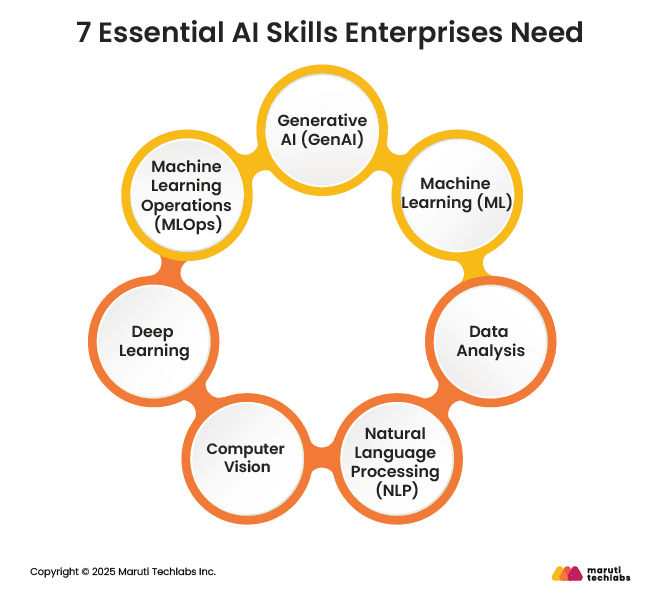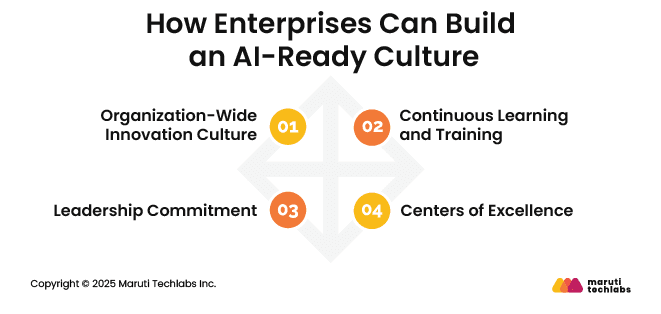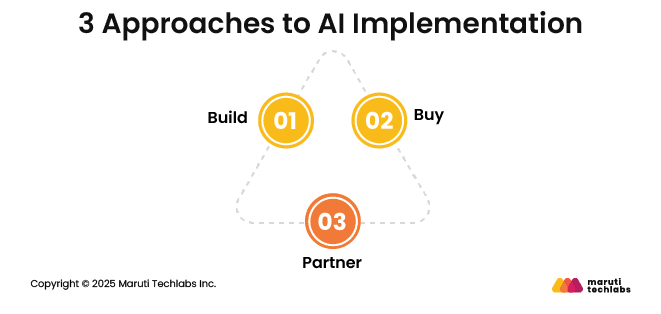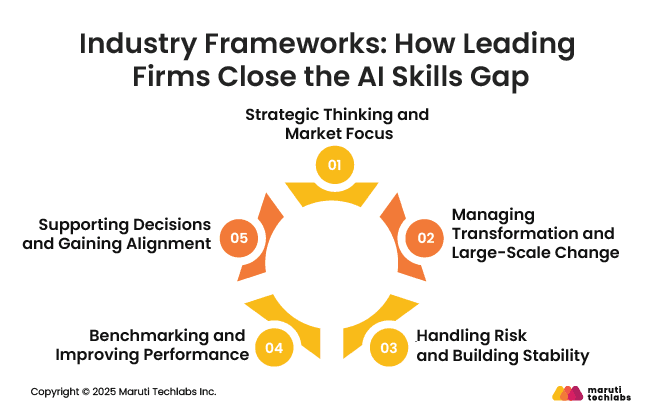

AI Skills Gap in Enterprises and How to Overcome It






The demand for AI skills is growing much faster than the number of skilled professionals available. Between 2015 and 2023, technical AI job listings increased by 257 percent, indicating the rapid pace at which companies are attempting to fill the AI skills gap. Today, almost one in four job openings requires some level of AI skill, even in non-technical roles such as HR or accounting.
However, many organizations are still struggling to find the right talent. About 68 percent of executives say their companies face a moderate to severe AI skills gap. This shortage is slowing down AI adoption and stopping enterprises from getting the full value of their investments. Research shows that companies with stronger AI capabilities perform better financially and stay ahead of their competitors.
As AI becomes a key part of every business, enterprises need to focus on both technical training and AI upskilling to build trust, collaboration, and readiness across teams.
This blog covers the essential AI skills enterprises need, how to build an AI-ready culture, approaches to AI implementation, and frameworks leading companies use to close the AI skills gap.
Closing the AI skills gap starts with understanding which skills matter most for modern enterprises. Here are seven essential AI skills every organization should focus on.

Teams should learn how AI tools can create text, images, or videos and use them in real business cases. For example, marketing teams can generate content drafts, while HR can automate communication workflows.
Machine learning forms the base of all AI technologies. Even if employees are not data scientists, knowing the basics helps them work better with technical teams and understand how models make predictions.
Strong data analysis skills help employees read, interpret, and visualize information effectively. When teams can draw useful insights from data tools, they make faster and more informed business decisions.
NLP helps machines understand human language. It is already used in chatbots, virtual assistants, and document analysis, improving communication and customer service.
Computer vision allows systems to process and analyze images or videos. It supports industries like retail, manufacturing, and healthcare in areas such as quality control, safety checks, and user experience.
Deep learning uses neural networks to solve complex problems. Knowing how it works helps organizations decide when to use advanced AI models for innovation.
MLOps ensures AI models are maintained, monitored, and updated correctly. It is an important area for AI upskilling for companies that want to scale their AI efforts efficiently.
Building an AI-ready culture is about more than just hiring people with the right AI skills. It starts with creating the right mindset across the organization. Companies need a culture that encourages innovation, collaboration, and continuous learning to close the AI skills gap and make AI adoption truly effective.

Enterprises should promote innovation across all departments instead of keeping AI limited to technical teams. When employees from marketing, finance, and operations collaborate, they can discover new ways to integrate AI into their daily tasks. This collaborative thinking helps in building practical AI applications that support larger business goals.
Learning never really stops, especially when it comes to new technology. Companies should offer regular workshops, short courses, and practice-based sessions that help employees build new skills over time. When people are given opportunities to learn and grow, they become more confident and better equipped to adapt to changes in the workplace.
Leaders shape how openly a company embraces new technology. When they show genuine interest, give clear direction, and stay involved, teams feel encouraged to experiment and find better ways to work. Strong leadership support helps everyone see how new tools fit into the bigger picture and how they can make daily tasks easier and more effective.
Establishing a Center of Excellence enables teams to share knowledge and adopt consistent best practices across the organization. These centers guide teams on how to plan, test, and use AI in real projects. They also make sure everyone stays focused on what the business needs.
When leadership commitment, collaboration, and continuous learning align, organizations naturally become more prepared to adopt AI. This kind of culture helps people try new ideas, learn from mistakes, and use AI to bring real value to the business.
Enterprises looking to adopt AI usually have three main choices: build their own solutions, buy ready-made tools, or partner with experts. Each approach has its own benefits and challenges, depending on the company’s goals, budget, and existing skills.

Building AI solutions in-house means creating a dedicated team of data scientists, ML engineers, and developers to design and manage custom tools.
This works best for companies with unique needs or access to valuable internal data. It provides complete control and flexibility but requires strong AI skills, sufficient funding, and time to maintain and update systems regularly. For most organizations, this is the most demanding option, but it can offer a long-term competitive advantage.
Buying off-the-shelf AI products is a faster and simpler option. Many tools are available in the market that help with automation, customer support, or data analysis. This approach is best for companies that want quick results without major development work. The main challenges include limited customization, integration with current systems, and dependency on external vendors.
Partnering with AI specialists allows companies to combine expert knowledge with their internal experience. It helps speed up AI implementation and reduce risks while focusing on business goals. This is ideal for organizations that need tailored solutions but lack in-house AI talent or want to scale quickly. Partnering also supports continuous AI upskilling by exposing internal teams to new skills and best practices.
Choosing between building, buying, or partnering depends on how ready the company is to handle AI development, manage costs, and effectively close its AI skills gap.
Enterprises across industries often look for structured ways to handle complex challenges. Leading organizations use proven frameworks that blend technology with strategic thinking to guide decision-making, manage change, and reduce risks. These approaches show how combining human expertise with AI upskilling can drive lasting business impact.

Strong decision-making starts with understanding market shifts and new opportunities. Companies use data-driven insights to refine their strategies, identify growth areas, and maintain a competitive edge. While AI tools help analyze trends, human judgment is key to turning those insights into real business action.
Enterprises going through digital transformation or restructuring rely on clear execution plans and cross-team alignment. AI can uncover inefficiencies, but only people can guide collaboration, handle internal resistance, and ensure that technology adoption matches business goals.
During uncertain times, businesses focus on managing risks and ensuring long-term stability. AI models can detect patterns or forecast issues, but human expertise is needed to understand real-world factors and maintain trust with customers, regulators, and investors.
Organizations measure their performance by comparing operations, costs, and efficiency with industry standards. AI speeds up benchmarking, but experienced teams interpret the results and define practical steps for improvement.
High-stakes business moves need clarity and stakeholder confidence. While AI provides data support, leadership communication and collaboration are what secure buy-in and drive execution.
At Maruti Techlabs, we have seen how combining AI tools with human expertise delivers real results. For instance, we assisted our client, a leading US-based car resale platform, in automating image verification using computer vision. Our solution handled 120,000 images per month, improved accuracy from 85% to 90%, and significantly reduced manual review time, helping the brand enhance both efficiency and customer experience.
AI adoption succeeds when organizations focus on the right combination of talent, culture, leadership, and strategic partnerships. Skilled employees and AI upskilling help teams use AI tools effectively and close the AI skills gap. A culture that encourages learning, collaboration, and innovation ensures AI solutions are adopted smoothly across the organization.
Strong leadership guides AI projects, sets clear goals, and aligns initiatives with business priorities. Strategic partnerships bring in specialized expertise, speed up implementation, and help deliver complex AI solutions. When supported by a solid foundation built through comprehensive AI Strategy & Readiness initiatives, these elements come together to help organizations turn technical and operational challenges into real competitive advantages.
At Maruti Techlabs, we develop AI-driven solutions that enable businesses to address critical challenges and enhance their operations. To learn more about our AI services, visit our AI services page. If you want to explore how our solutions can support your business, reach out through our contact us page.
To evaluate your organization’s current AI maturity and identify skill or process gaps, try our AI Readiness Assessment Tool — a simple way to understand where you stand and how to accelerate your AI transformation journey.
The AI skills gap refers to the difference between the growing demand for AI expertise and the limited supply of skilled professionals. Many organizations struggle to find employees with expertise in machine learning, data analysis, natural language processing, and other AI areas, which slows adoption and innovation.
AI can help close the skills gap by automating repetitive tasks, supporting decision-making, and providing intelligent training tools. AI-powered learning platforms can upskill employees faster, while AI applications can enhance productivity, allowing organizations to do more with existing talent and focus human expertise on higher-value work.
The most in-demand AI skills include machine learning, deep learning, data analysis, natural language processing, computer vision, generative AI, and MLOps. Professionals with a combination of technical expertise, problem-solving ability, and the capacity to apply AI solutions across business functions are especially sought after.
Examples of AI skill gaps include insufficient machine learning knowledge, a lack of expertise in data visualization, limited experience with NLP or computer vision, a weak understanding of model deployment and MLOps, and inadequate training in AI ethics or responsible AI practices. These gaps hinder effective AI adoption.
Advanced AI skills like deep learning, machine learning engineering, and AI research roles tend to command the highest salaries. Professionals who can design and implement AI models, manage large-scale AI projects, or create cutting-edge AI solutions are often the best compensated in the AI job market.


